Google Chromecast Review - An Awesome $35 HDMI Dongle
by Brian Klug on July 29, 2013 9:45 PM EST- Posted in
- Smartphones
- Media Player
- Android
- Mobile
- HDMI
- Chrome
- Tablets
- Chromecast
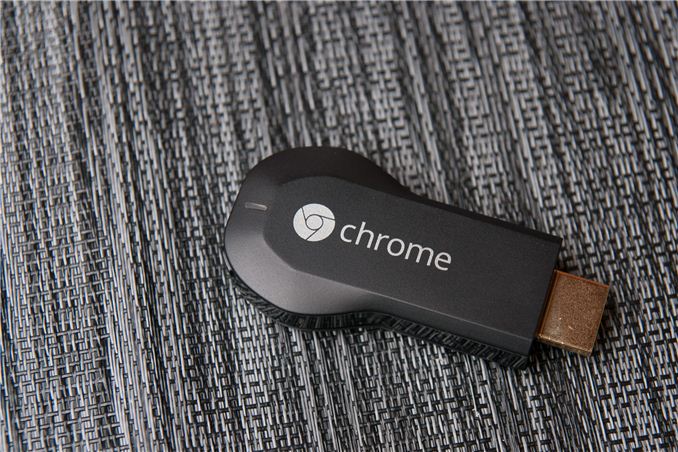
So I have a confession to make – I didn’t hate the Nexus Q. While I didn’t necessarily love it and use it daily like a small minority of my peers did, I also didn’t immediately declare the product an unmitigated disaster like the vast majority of people. The fate of that product was so quickly decided that I hadn’t even begun writing my review when the whole thing was terminated. When I spoke with Googlers about Nexus Q, what was obvious to me was that the Q had begun as an audio-only product that later on had HDMI added, and that tiny bit of context made all the difference in understanding the choices behind it. I left the Nexus Q plugged into my AV Receiver up until the most recent set of Google Play apps killed functionality entirely.
Ultimately the price of the Nexus Q was its undoing ($299), not necessarily its functionality or even its somewhat awkward spherical form factor. The concept was relatively sound – a network-attached appliance that played back movies and music from Google’s servers directly, rather than streaming them from device to device on the same network. The Q ran Android 4.x atop an OMAP4460, literally the same platform as the then-flagship Galaxy Nexus, just sans cellular connectivity, which made it a logical choice.
The Nexus Q was killed off before other services could be added, but at a high level the Q’s functionality as a playback device rather than streaming endpoint carried onto its successor, the Chromecast.
The Chromecast is obviously everything the Q should’ve been. It’s a simple, small, $35 HDMI dongle, powered by USB, that’s designed to discreetly plug into the back of a TV. There’s been much talk about the power requirement of the Chromecast, USB is indeed required for operation, but just about every modern TV has USB ports on the side for attaching mass storage or powering accessories like this. In fact, the Chromecast’s form factor is already a popular one for Android-powered HDMI dongles and Miracast sinks, as well as a variety of other small appliances. I’ve confirmed with Google that MHL-HDMI is not in fact supported by the Chromecast, meaning it can’t be powered by a TV that includes the spec (which can deliver up to 500 mA at 5 V), straight HDMI can only supply 50 mA at 5V. I’ve yet to encounter a TV with MHL-HDMI myself, including on the 55-inch LCD TV I purchased just 3 months ago.
Inside the box for the Chromecast is the device itself, a relatively long microUSB cable, USB power supply, and HDMI extender. Funnily enough the USB power supply appears to be the exact same as the previous generation Motorola USB charger (5V, 850 mA), just with a different exterior – is this the first Motorola product out of Google proper?
The HDMI extender cable helps get the Chromecast behind a TV if you need to turn it 90 degrees or have an inset port with inadequate clearance like I do on my front-facing HDMI accessory port.
There’s not much to talk about regarding aesthetics of the Chromecast itself, it’s a dongle with a rounded bulge at one end, and HDMI port at the other. There’s a reset button on the side, microUSB port for power, and a status LED on top. On the bottom are regulatory markings. My only complaint about the Chromecast’s design is this status LED, which inexplicably is bright solid white whenever the device is on, making it distracting in a dark living room or bedroom. Nothing electrical tape can’t solve, but an inexplicably poor choice for a media center playback device given that bright LEDs are a known no-no.
The hardware is what it needs to be – small, simple, and conducive to the low price point. The Nexus Q was a solid bowling ball in comparison, primarily thanks to the analog audio amplifier and hardware it really didn’t need. By keeping unnecessary I/O to a minimum the Chromecast ends up being a nice and small streaming appliance.


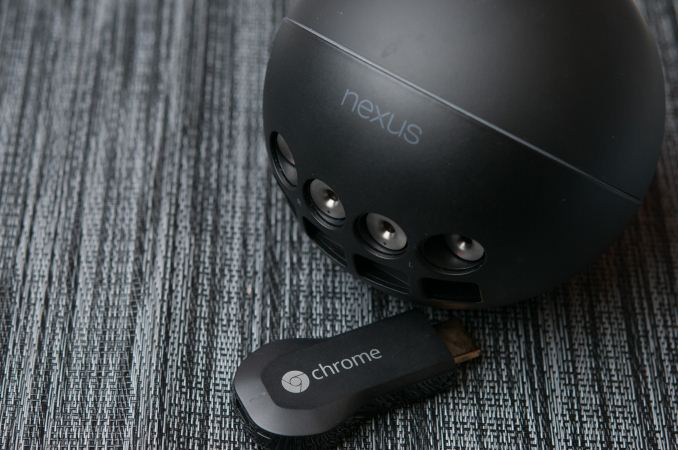
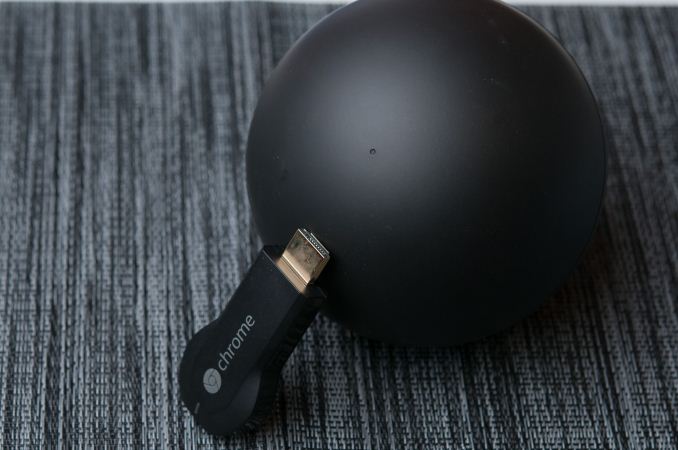

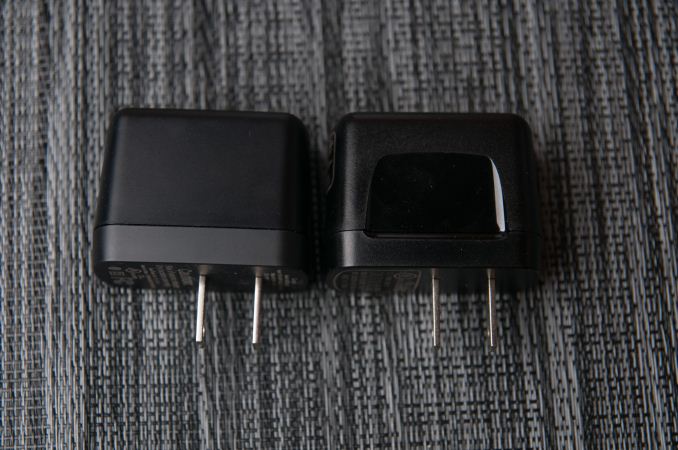






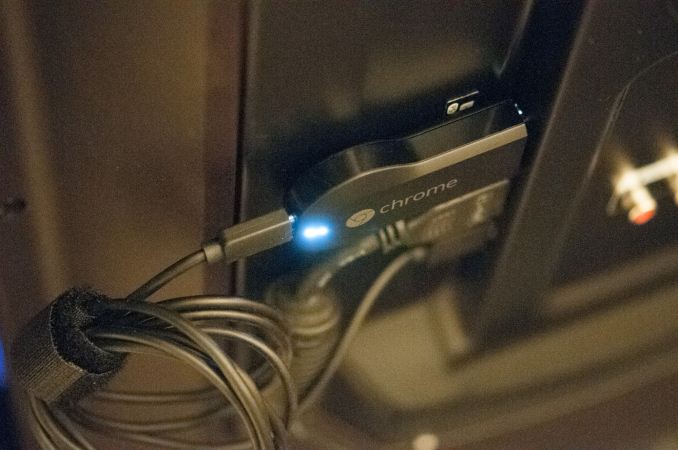








105 Comments
View All Comments
dvinnen - Monday, July 29, 2013 - link
Looking at it, the WiFi chip supports bluetooth 3.0. If google enabled controlling it via bluetooth it would be awesome for travel. Not sure that is possible though with he bluetooth specBrazos - Monday, July 29, 2013 - link
I assume this would work if plugged into a HDMI port on my AVI receiver (so I can enjoy sound thru my stereo)? Only problem might be the wireless connection due to it's location in the rear of the receiver. HDMI extension cable?Brian Klug - Monday, July 29, 2013 - link
That's exactly what I did, even on the floor/close to it (bottom shelf of the media cabinet) it works fine.-Brian
savagemike - Monday, July 29, 2013 - link
Would love an article on the miracast week you've had. Been thinking about trying that out and would love to hear more about the pitfalls.Given the new golden-child Nexus 7 (2013) apparently supports it that would be a great context for an article.
joeballow - Monday, July 29, 2013 - link
I do plan on getting one, but I wish they made a wired version with ethernet instead of wifi. I live in a crowded apartment building and prefer to hard wire anything that isn't mobile. It seems they could hit the same price point by dropping wifi and adding ethernet unless wifi is already integrated into the chip? If that's the case I'd pay $10 more for a wired/wireless version.LeftSide - Monday, July 29, 2013 - link
Just got mine in the mail. It's quite useful for $35, and if more developers get on board it could be great.Alketi - Monday, July 29, 2013 - link
Brian, if your attached pictures are any indication, you WANT a bright LED behind your TV screen.It provides a constant level ambient lighting, which allows your eyes to adjust, rather than be carried solely by the brightness of each TV/Movie scene.
Brian Klug - Tuesday, July 30, 2013 - link
Well that's true, but not when I'm in my bedroom and the TV/lights are off and I'm trying to sleep, and the Chromecast lights up a corner of the room. Seriously, the thing is BRIGHT!-Brian
ioconnor - Monday, July 29, 2013 - link
What does this thing do? All I got from skimming was that it wasn't some other product. And that whatever it is suppose to do might not be done. Yet.Better yet go back to talking about computers. That I can understand.
Kepe - Thursday, August 1, 2013 - link
Eh.. Perhaps you should read the article properly before commenting you don't understand it.